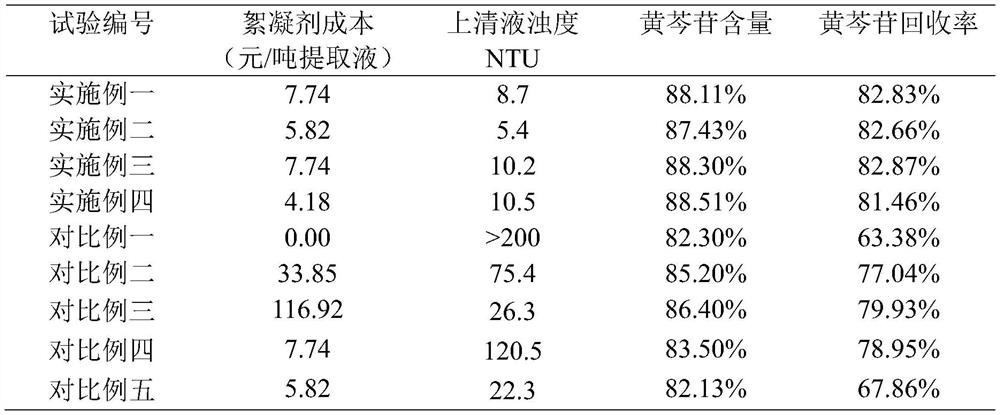A flocculation and impurity removal process of Scutellaria baicalensis extract and its application
A Scutellaria baicalensis extract and flocculation technology are applied in the directions of medical preparations containing active ingredients, plant/algae/fungus/moss components, sugar derivatives, etc. The problem of low extraction rate is to achieve the effect of facilitating subsequent filtration, reducing co-precipitation and simple process
- Summary
- Abstract
- Description
- Claims
- Application Information
AI Technical Summary
Problems solved by technology
Method used
Image
Examples
Embodiment 1
[0054] (1) Take 200 g of Scutellaria baicalensis, slice it, heat it with steam to inactivate enzymes, extract it with 1800 ml of water under reflux for 2 hours, then extract it twice with 700 ml×2 water under reflux, each time for 1 hour, and combine the extracts;
[0055] (2) Heat the extract at 80-90°C, add 50 g of previously prepared bentonite (1%) suspension under stirring, stir evenly, and adjust pH=4.8 with dilute hydrochloric acid;
[0056] (3) Add 42g of 20% calcium chloride solution prepared in advance at 80-90°C, and stir evenly;
[0057] (4) under stirring, adjust the pH value to 5.8-6.0 with 20% sodium hydroxide;
[0058] (5) Leave it to stand at heat preservation, generate large flocs to precipitate, settle for 1 to 2 hours, and take samples to check the flocculation effect;
[0059] (6) filtering the supernatant;
[0060] (7) The filtrate is heated to 80-90° C., and the pH is adjusted to 1.5-2 with hydrochloric acid to generate baicalin precipitation;
[0061]...
Embodiment 2
[0063] (1) Take 200 g of Scutellaria baicalensis, slice it, heat it with steam to inactivate enzymes, extract it with 1800 ml of water under reflux for 2 hours, then extract it twice with 700 ml×2 water under reflux, each time for 1 hour, and combine the extracts;
[0064] (2) Add 42g of 20% calcium chloride solution prepared in advance at 80-90°C, and stir evenly;
[0065] (3) adjust the pH value to 5.8-6.0 with 20% sodium hydroxide under stirring;
[0066] (4) Leave it standing for heat preservation, generate large flocs to precipitate, settle for 1 to 2 hours, and take samples to check the flocculation effect;
[0067] (5) filtering the supernatant;
[0068] (6) The filtrate is heated to 80-90° C., and the pH is adjusted to 1.5-2 with hydrochloric acid to generate baicalin precipitation;
[0069] (7) Filtrate, wash with water, and dry to obtain the crude extract of baicalin.
Embodiment 3
[0071] (1) Take 200g of Scutellaria baicalensis, slice it, heat it with steam to inactivate the enzyme, extract it with 1800ml of water under reflux for 2 hours, then extract it twice with 700ml×2 water under reflux, each time for 1 hour, and combine the extracts, weighing about 2500g;
[0072] (2) Heat the extract at 80-90°C, add 50 g of previously prepared bentonite (1%) suspension under stirring, stir evenly, and adjust pH=4.8 with dilute hydrochloric acid;
[0073] (3) Add 42 g of 20% magnesium chloride solution prepared in advance, and stir for 10 min;
[0074] (4) adjust the pH value to 5.2-5.5 with 20% sodium hydroxide;
[0075] (5) Leave it to stand at heat preservation, generate large flocs to precipitate, settle for 1 to 2 hours, and take samples to check the flocculation effect;
[0076] (6) filtering the supernatant;
[0077] (7) The filtrate is heated to 80-90° C., and the pH is adjusted to 1.5-2 with hydrochloric acid to generate baicalin precipitation;
[007...
PUM
 Login to View More
Login to View More Abstract
Description
Claims
Application Information
 Login to View More
Login to View More - R&D
- Intellectual Property
- Life Sciences
- Materials
- Tech Scout
- Unparalleled Data Quality
- Higher Quality Content
- 60% Fewer Hallucinations
Browse by: Latest US Patents, China's latest patents, Technical Efficacy Thesaurus, Application Domain, Technology Topic, Popular Technical Reports.
© 2025 PatSnap. All rights reserved.Legal|Privacy policy|Modern Slavery Act Transparency Statement|Sitemap|About US| Contact US: help@patsnap.com

